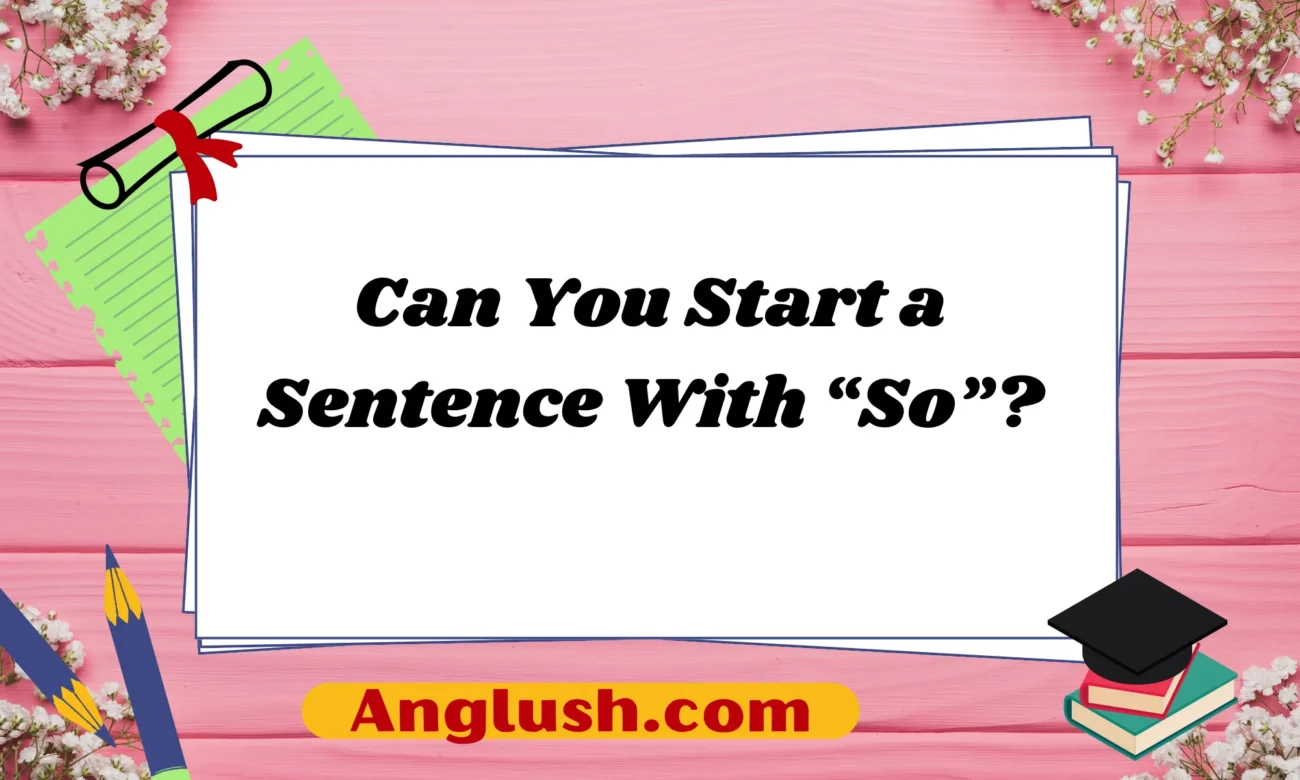Introduction
The English language is constantly evolving, and one of the most common linguistic habits today is beginning a sentence with the word so. You’ve probably heard it in everyday conversations, business meetings, and even formal presentations. But is it grammatically correct? Is it appropriate in professional writing? And are there better alternatives depending on the context?
In this article, we’ll explore the role of so at the beginning of a sentence, examine its impact on tone and meaning, and provide alternative ways to start a sentence more effectively in formal and informal settings.
Is It Correct to Start a Sentence With “So”?
Yes, it is grammatically acceptable to start a sentence with so, but its appropriateness depends on the context.
When Is It Acceptable?
Using so at the beginning of a sentence is common in casual speech and writing. It is often used to:
- Introduce a conclusion or result (So, we decided to take a different route.)
- Transition between ideas (So, as I was saying…)
- Start an explanation (So, the reason we chose this approach is…)
When Should You Avoid It?
In formal or professional writing, starting with so can sometimes sound informal, vague, or even unnecessary. In academic essays, official reports, or business communications, it’s often better to use a more precise transition word or phrase.
Better Alternatives to Starting a Sentence With “So”
To ensure clarity and professionalism, consider using different words or phrases instead of so. Below are various alternatives based on context.
1. Formal Alternatives (for academic, business, and professional writing)
If you are writing a formal document or email, using precise transitions can enhance clarity and professionalism. Here are some alternatives:
- Therefore – Indicates a logical conclusion (Therefore, we must reconsider our approach.)
- Thus – Slightly more formal than therefore (Thus, the data suggests a different outcome.)
- Consequently – Highlights a cause-and-effect relationship (Consequently, the project timeline has been adjusted.)
- As a result – Emphasizes an outcome (As a result, our strategy has shifted.)
- Hence – Similar to therefore, often used in academic writing (Hence, we propose an alternative method.)
2. Neutral Alternatives (for general communication)
If you are writing something that isn’t too formal or too casual, these options work well:
- Accordingly – Shows a response to previous information (Accordingly, we have updated our plans.)
- Because of this – Connects to a prior statement (Because of this, we will need additional resources.)
- For this reason – Emphasizes reasoning (For this reason, we recommend a different solution.)
- With this in mind – Shows consideration of previous points (With this in mind, let’s explore alternative options.)
3. Casual Alternatives (for everyday conversations, texting, and informal emails)
For informal situations, these alternatives sound natural and friendly:
- Anyway – Moves the conversation forward (Anyway, what do you think about the idea?)
- Well – Softens the transition (Well, I think we should try a different approach.)
- By the way – Introduces a new thought (By the way, have you seen the latest update?)
- That being said – Acknowledges a previous point before adding a new one (That being said, I do like the design.)
- You know – Engages the listener (You know, I think we should revisit our plan.)
10 Texting Examples Without Using “So”
When texting, we often start messages with so out of habit. Here are 10 examples of alternative ways to phrase your texts:
- Instead of: So, what are you doing later?
Try: Hey, what are you up to later? - Instead of: So, are we still meeting at 7?
Try: Just checking—are we still meeting at 7? - Instead of: So, I heard you got a promotion!
Try: Wow, I heard you got a promotion! Congrats! - Instead of: So, are you feeling better today?
Try: Hope you’re feeling better today! - Instead of: So, what’s the plan for the weekend?
Try: Any plans for the weekend? - Instead of: So, I was thinking about our trip…
Try: I was thinking about our trip—do we need to book anything? - Instead of: So, do you still need help with that?
Try: Do you still need help with that? Let me know! - Instead of: So, how did the meeting go?
Try: How did the meeting go? Hope it went well! - Instead of: So, are you free for lunch tomorrow?
Try: Are you free for lunch tomorrow? Let me know! - Instead of: So, I think we should talk.
Try: I think we should talk—when’s a good time for you?
How to Choose the Best Alternative
The right alternative depends on the tone and formality of your communication. Here’s a quick guide:
- Use formal options (therefore, thus, consequently) for professional and academic writing.
- Use neutral options (accordingly, for this reason, because of this) for general or workplace communication.
- Use casual options (anyway, well, by the way) for everyday conversation, texts, and informal emails.
If you’re unsure, read your sentence out loud. If so feels unnecessary, replace it with a clearer transition—or remove it altogether.
Conclusion
While it is grammatically correct to start a sentence with so, it’s not always the best choice, especially in formal writing. By using more precise alternatives, you can make your communication clearer, more professional, and better suited to the context.
Whether you’re writing a business email, an academic essay, or a casual text, there’s always a better way to start a sentence without relying on so. Try experimenting with different alternatives and see how they improve the clarity and flow of your writing!

